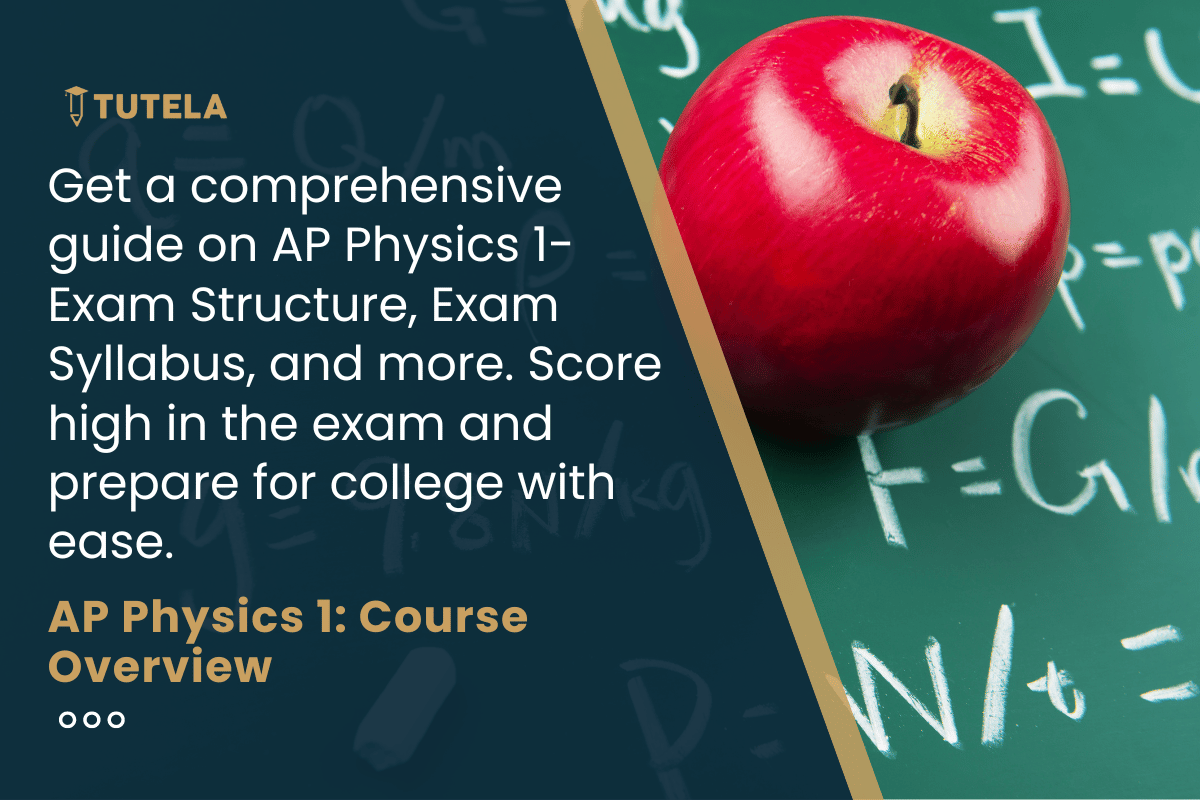
In this blog, we aim to be the go-to guide for students, breaking down the entire syllabus of AP Physics 1 in a concise and engaging manner. From foundational concepts to real-world applications, we'll navigate the essential principles of classical mechanics. The AP Physics 1 Exam date is scheduled for 17th May 2024. For other AP Exams 2024 dates and test center information, please refer here.
| Unit Name | Description | Weightage in the Exam |
| Unit 1: Kinematics | Kinematics is the study of motion without considering the forces causing it. Topics in this unit include displacement, velocity, acceleration, and graphical representations of motion. It sets the groundwork for understanding how objects move and change position over time. | 12-18% |
| Unit 2: Dynamics | Dynamics deals with the forces that cause motion. This unit explores concepts like Newton's laws of motion, force, mass, and the relationship between force and acceleration. Students learn to analyze and predict the motion of objects under the influence of forces. | 16-20% |
| Unit 3: Circular Motion and Gravitation | This unit extends the understanding of motion to circular paths and the force of gravity. Topics may include centripetal force, gravitational force, and the principles governing the motion of objects in circular orbits. | 6-8% |
| Unit 4: Energy | Energy is a fundamental concept in physics. This unit covers the various forms of energy, including kinetic and potential energy. Students learn about the conservation of energy and how energy is transferred and transformed in physical systems. | 20-28% |
| Unit 5: Momentum | Momentum is the product of an object's mass and velocity. This unit explores the principles of momentum, impulse, and the conservation of momentum. It helps students analyze collisions and understand how momentum is conserved in these interactions. | 12-18% |
| Unit 6: Simple Harmonic Motion | Simple Harmonic Motion (SHM) involves repetitive back-and-forth motion, often described by sinusoidal functions. This unit may cover the principles of oscillation, period, frequency, and amplitude in systems exhibiting simple harmonic motion. | 4-6% |
| Unit 7: Torque and Rotational Motion | This unit focuses on rotational dynamics, including concepts like torque, angular displacement, and rotational equilibrium. It extends the principles of dynamics to objects rotating around an axis, providing a bridge between linear and angular motion. | 12-18% |
1. Multiple-choice section: This section consists of 50 questions and lasts for 1 hour and 30 minutes. It covers various topics, including kinematics, dynamics, circular motion, energy, momentum, simple harmonic motion, and waves.
2. Free-response section: This section consists of 5 questions and lasts for 1 hour and 30 minutes. It assesses students' ability to solve physics problems and communicate their understanding through written responses.
1. Physics and Astrophysics: AP Physics 1 lays the groundwork for students pursuing majors in physics and astrophysics, providing essential principles for understanding the fundamental laws governing the universe.
2. Mechanical Engineering: Aligned with the curriculum of mechanical engineering majors, the course offers a comprehensive understanding of forces, motion, and energy.
3. Civil Engineering: Understanding the principles of motion and forces is crucial in civil engineering, making AP Physics 1 beneficial for those aspiring to contribute to infrastructure design.
4. Aerospace Engineering: Relevant for careers in aerospace engineering, the course covers dynamics and motion principles fundamental to aircraft and spacecraft design.
5. Computer Science and Engineering: The analytical and problem-solving skills developed in AP Physics 1 complement the requirements of computer science and engineering majors, contributing to success in software and hardware development.
6. Electrical Engineering: Concepts of motion and forces are applicable in electrical engineering, making the course valuable for students interested in understanding the behavior of electrical systems.
7. Applied Mathematics: The integration of mathematical concepts in AP Physics 1 provides a strong background beneficial for students pursuing majors in applied mathematics, where mathematical modeling is essential.
8. Biomedical Engineering: For those interested in the intersection of physics and biology, particularly in understanding the mechanics of living organisms, AP Physics 1 provides relevant insights for biomedical engineering majors.
9. Materials Science: Mechanics plays a crucial role in materials science, and students exploring this field can benefit from the foundational knowledge offered in AP Physics 1.
10. Environmental Science: The course's focus on forces and energy is relevant to environmental science, where understanding the impact of natural processes on the environment is essential for sustainable practices.
TutelaPrep’s College Navigator allows students to search for colleges based on their preferred country and course. Not only that, it also provides valuable insights into each college’s specific admission requirements for those exams. Through College Navigator, you can even connect with alumni at your chosen colleges to get a firsthand feel for campus life and academics.
We hope this article helped you with the subject knowledge. Reach out to us by filling out our assistance form if you need any help with the preparations.